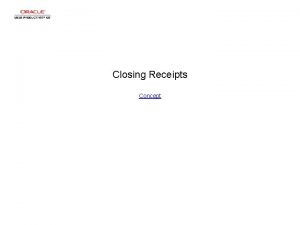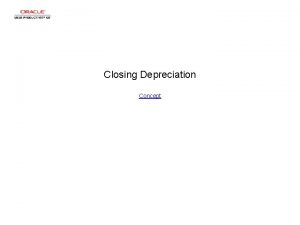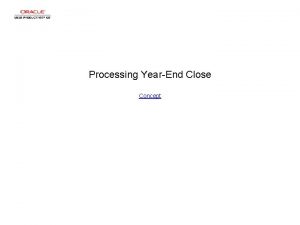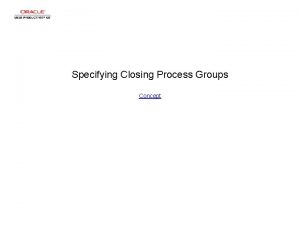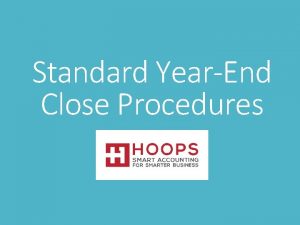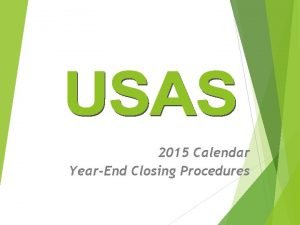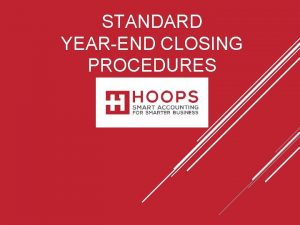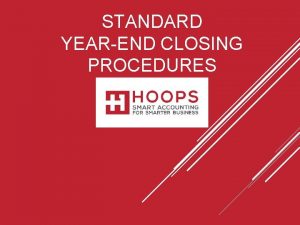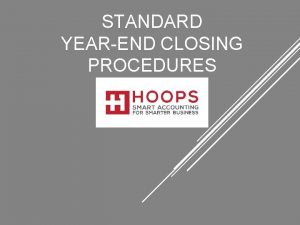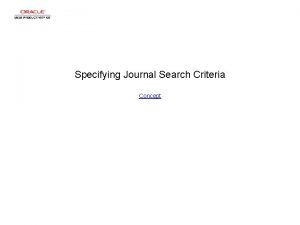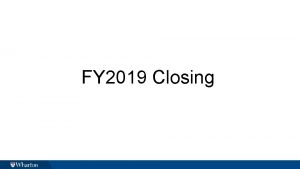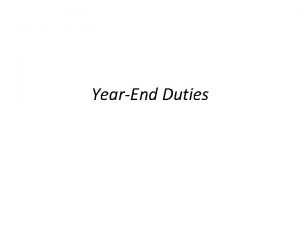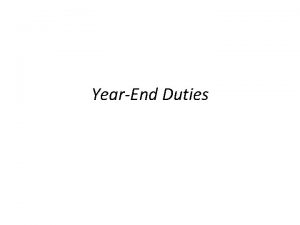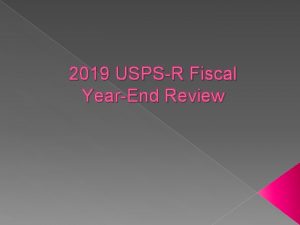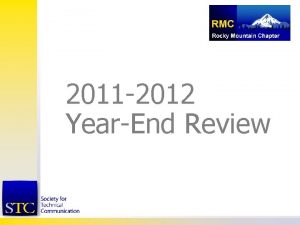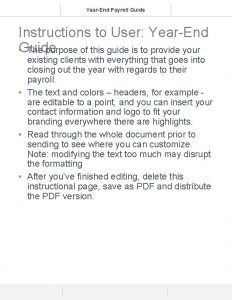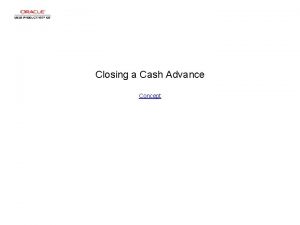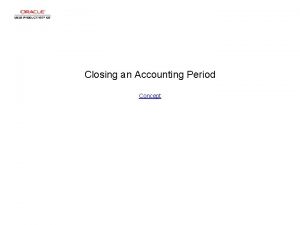Specifying Closing Rules for YearEnd Close Concept Specifying








































































- Slides: 72

Specifying Closing Rules for Year-End Close Concept

Specifying Closing Rules for Year-End Close

Specifying Closing Rules for Year-End Close Step 1 Begin by navigating to the Closing Rules page. Click the vertical scrollbar.

Specifying Closing Rules for Year-End Close Step 2 Click the General Ledger menu.

Specifying Closing Rules for Year-End Close Step 3 Click the Close Ledgers menu.

Specifying Closing Rules for Year-End Close Step 4 Click the Closing Rules menu.

Specifying Closing Rules for Year-End Close Step 5 Click the Add a New Value tab.

Specifying Closing Rules for Year-End Close Step 6 Click in the Closing Rule field.

Specifying Closing Rules for Year-End Close Step 7 Enter the desired information into the Closing Rule field. Enter "MANUYE".

Specifying Closing Rules for Year-End Close Step 8 Click the Closing Type list.

Specifying Closing Rules for Year-End Close Step 9 Click the Year End list item.

Specifying Closing Rules for Year-End Close Step 10 Click the Add button.

Specifying Closing Rules for Year-End Close Step 11 Use the Closing Options page to define the closing scope and other closing options.

Specifying Closing Rules for Year-End Close Step 12 Use the Effective Date field to specify the date from which the closing rule is valid. The current system date is the default value but you can change it.

Specifying Closing Rules for Year-End Close Step 13 Use the Status field to specify the status as Active or Inactive.

Specifying Closing Rules for Year-End Close Step 14 Use the Description field to briefly describe the closing rule that will appear on pages and reports. In this example, you are specifying that you will close profit and loss (P/L) accounts for administrative departments to retained earnings account. All other departments' P/L accounts will close to account 360000 and retain the original department number. Click in the Description field.

Specifying Closing Rules for Year-End Close Step 15 Enter the desired information into the Description field. Enter "Close to single acct w/dept".

Specifying Closing Rules for Year-End Close Step 16 Use the Ledger Template field to enter the ledger template associated with the ledger to be closed. This template determines the Chart. Fields that are listed in the selection fields for this closing rule. Only the Chart. Fields defined for the selected ledger template can be included in the closing rules. For this example, accept the default value.

Specifying Closing Rules for Year-End Close Step 17 Use the Chart. Field field to specify the Account Chart. Field required for yearend closing. For year-end closing, all P/L accounts must be closed to retained earnings. All P/L accounts will close to the account specified here unless overridden on the Net Income/Retained Earnings page. Click the Chart. Field list.

Specifying Closing Rules for Year-End Close Step 18 Click the Account list item.

Specifying Closing Rules for Year-End Close Step 19 Use the Chart. Field Value field to enter the retained earnings account value that will be used as a default. In this example, 360000 is the retained earnings account for all departments that are not administrative departments. Click in the Chart. Field Value field.

Specifying Closing Rules for Year-End Close Step 20 Enter the desired information into the Chart. Field Value field. Enter "360000".

Specifying Closing Rules for Year-End Close Step 21 Click the Add a new row button.

Specifying Closing Rules for Year-End Close Step 22 Click the Chart. Field list.

Specifying Closing Rules for Year-End Close Step 23 Click the Department list item.

Specifying Closing Rules for Year-End Close Step 24 Use the Retain CFV option to have the system retain the Chart. Field value from the ledger. The Retain CFV option is not allowed if the Chart. Field is Account. If this check box is selected, then the Chart. Field Value field must be blank. If the check box is deselected, then you must specify a specific value for the Chart. Field. Click the Retain CFV option.

Specifying Closing Rules for Year-End Close Step 25 Click the Year End Closing Options link to access the year end close options. The link is available only for year end closings. Click the Year End Closing Options link.

Specifying Closing Rules for Year-End Close Step 26 Use the Year End Close Options page to select year end close processing options.

Specifying Closing Rules for Year-End Close Step 27 You can perform year end close on either the Account Chart. Field or the Alternate Account Chart. Field. In addition, you can define a year end closing rule on the Alternate Account only. In this case, no Account Chart. Field is required for retained earnings, P/L Chart. Field value sets, or roll-forward Chart. Field value sets. Closing populates the Account Chart. Field with the default values for the particular Alternate Account Chart. Field. However, you can enter an Account Chart. Field to accompany the Alternate Account Chart. Field if you want. To perform a year end close by Alternate Account Chart. Field only, select ALTACCT in the Close by field. In the close sequence, you typically perform a currency translation from the

Specifying Closing Rules for Year-End Close Step 28 Use the Set Default Retained Earnings option to use the default retained earnings that you define on the Closing Options page. If not used, you must use the Net Income/Retained Earnings page to define all accounts to be closed. If you do not select this option, no default retained earnings account exists for P/L accounts that may have inadvertently been omitted on the Net Income/Retained Earnings page. When you use the balance sheet indicator option at the installation level, this option is set to Off, and it is displayonly.

Specifying Closing Rules for Year-End Close Step 29 Use the Create Jrnl by RE Group option to have year end close create separate journals for each P/L Chart. Field value set group and retained earnings pair; that is, one journal for one Chart. Field value group number. For example, to have a separate journal for each department, you might enter DEPTID in the Chart. Field value set criteria, as well as in the retained earnings Chart. Fields on the Net Income/Retained Earnings page and then select this option.

Specifying Closing Rules for Year-End Close Step 30 Use the Close the G/L Open Periods option to close all open general ledger periods for the business-unit-and-ledgergroup combination and year being closed. This prevents any additional journals from being entered for the year that is being closed.

Specifying Closing Rules for Year-End Close Step 31 Use the Close Adjustment Periods option to close all open adjustment periods for the business-unit-and-ledgergroup combination and year being closed

Specifying Closing Rules for Year-End Close Step 32 Use the Store P/L Reversal Entries option to store P/L offsets in period 999 (where the closing entries for all accounts are stored). If you use this option, the system inserts ledger rows for the entries made to period 999 to close revenue and expense accounts. You can access these amounts using the General Ledger inquiry pages. If this option is not used, offsets are not stored in period 999. If you used period 999 for reports, the ledger will be out of balance.

Specifying Closing Rules for Year-End Close Step 33 Use the Initialize DR/CR with Net Bal option to begin the year with net balances of debits and credits, instead of carrying forward separate balances for debits and credits. This option is available only if you have enabled separate debits/credits (DR/CR) on the database. When separate DR/CR is enabled, the period 999 entries for profit and loss accounts offset not only the net ending balances, but also the debit and credit ending balances. This option enables you to begin the year with net balances of debits/credits, instead of carrying forward separate balances for debits and credits. If used, the debit or credit balances are initialized with the net period zero balance. If the net balance is positive, this amount is placed in the DR column for period 0; if the net balance is

Specifying Closing Rules for Year-End Close Step 34 Use the Close DR/CR with Net Balance option if you are using the separate debit/credit modification and want to net the separated debit and credit amounts during year end closing for the equity—profit and loss accounts before posting a single net amount to period 999.

Specifying Closing Rules for Year-End Close Step 35 For this example, accept the default selections. Click the OK button.

Specifying Closing Rules for Year-End Close Step 36 Use the Copy icon to copy the closing rules to another closing rule. The system displays a Copy Step window where you enter a new name for the process step. When you change the name and click the OK button, the system displays a message that the current process step is copied to a new process step. This icon is available only if you re-open this Closing Options page.

Specifying Closing Rules for Year-End Close Step 37 Use the Rename icon to rename the closing rule as long as it is not being used by a closing process group. This icon is available only if you re-open this Closing Options page.

Specifying Closing Rules for Year-End Close Step 38 Use the Delete icon to delete the closing rule as long as it is not being used by a closing process group. This icon is available only if you re-open this Closing Options page.

Specifying Closing Rules for Year-End Close Step 39 Click the Reversal Entry Chartfields link to access the Year End Reversal Entry Chartfields page. Click the Reversal Entry Chartfields link.

Specifying Closing Rules for Year-End Close Step 40 Use the Year End Reversal Entry Chartfields page to select the Chart. Fields for which you want to retain reversal entry values. This option can improve processing performance.

Specifying Closing Rules for Year-End Close Step 41 For this example, accept the default selections. Click the OK button.

Specifying Closing Rules for Year-End Close Step 42 Click the Net Income/Retained Earnings tab.

Specifying Closing Rules for Year-End Close Step 43 Use the Net Income/Retained Earnings page to identify the profit and loss (P/L) Chart. Field value sets, and the retained earnings Chart. Fields for the closing.

Specifying Closing Rules for Year-End Close Step 44 Select the Close To Multiple Ret Earnings option to close to multiple retained earnings accounts. If deselected (year end closings only), the system uses the default account for retained earnings defined on the Closing Options page. All P/L accounts will close to the default retained earnings account. This option is required when the Book Code option, the Balance Sheet option, or the Off-Balance Sheet option is selected at installation. Click the Close To Multiple Ret Earnings option.

Specifying Closing Rules for Year-End Close Step 45 The system uses the values in the Chart. Field Value Set field to identify the P/L accounts that close to the retained earnings account that you enter in the Retained Earnings group box. For best system performance, select Chart. Field value sets that have the same Chart. Field combinations. For example, if you select Chart. Field value sets 1, 2, and 3, and Chart. Field value set 1 includes the Department Chart. Field and the Project Chart. Field, then the other Chart. Field value sets should also include Department and Project. If they included different Chart. Fields (for example Product and Project), then processing the close may take longer and be less efficient. Select the Chart. Field Value Set for the P/L accounts to be closed. If there are other P/L Chart. Field value sets that

Specifying Closing Rules for Year-End Close Step 46 You can click the lookup prompt and select a Chart. Field Value Set from the list or enter the value in the Chart. Field Value Set field. Enter the desired information into the Chart. Field Value Set field. Enter "INCOM_ACCT_ADMIN_DIV".

Specifying Closing Rules for Year-End Close Step 47 Use the Update/New link to access the Setup Chart. Field Value Sets page, where you can create or update a Chart. Field value set to use as P/L Chart. Field value set.

Specifying Closing Rules for Year-End Close Step 48 Use the Retained Earnings section to define the mapping of P/L accounts to the retained earnings accounts.

Specifying Closing Rules for Year-End Close Step 49 Use the Chart. Field field to specify the Account Chart. Field that is required for year-end closing. Click the Chart. Field list.

Specifying Closing Rules for Year-End Close Step 50 Select the Account Chart. Field from the list. Click the Account list item.

Specifying Closing Rules for Year-End Close Step 51 Use the Chart. Field Value field to enter the retained earnings account value that will be used for the specified value set. In this example, 360100 is the account code used for administrative departments. Click in the Chart. Field Value field.

Specifying Closing Rules for Year-End Close Step 52 Enter the desired information into the Chart. Field Value field. Enter "360100".

Specifying Closing Rules for Year-End Close Step 53 Click the Journal Options tab.

Specifying Closing Rules for Year-End Close Step 54 Use the Journal Options page to define journal options for system-generated journals created during the close.

Specifying Closing Rules for Year-End Close Step 55 Use the Journal ID Mask field to enter a prefix for naming closing journals. Journals are identified by a 10 character alphanumeric ID. The system automatically appends the prefix that you specify here to the journal IDs. For example, if you specify the journal ID mask as YEC, the year end closing journal IDs might be YEC 0001, YEC 0002, and so on. Alternatively, the value NEXT causes the system to assign the next available journal ID number automatically, without including the mask. (This option makes it more difficult to identify the closing journals. ) Reserve a unique mask value for closing to ensure that no other process creates identical journal IDs. Click in the Journal ID Mask field.

Specifying Closing Rules for Year-End Close Step 56 Enter the desired information into the Journal ID Mask field. Enter "YE".

Specifying Closing Rules for Year-End Close Step 57 Use the Source field to identify the originating responsibility for the journal entries being created. The code for the Closing Journal Source is CLO. Click in the Source field.

Specifying Closing Rules for Year-End Close Step 58 Enter the desired information into the Source field. Enter "CLO".

Specifying Closing Rules for Year-End Close Step 59 If you use the Document Sequencing feature, use the Closing Doc Type field to select a predefined closing document type for the closing journals. The Document Sequencing feature requires that you identify a document type for all created journal entries. In this example, FS-CLS is the code for Closing Journals. Click in the Closing Doc Type field.

Specifying Closing Rules for Year-End Close Step 60 Enter the desired information into the Closing Doc Type field. Enter "FSCLS".

Specifying Closing Rules for Year-End Close Step 61 Use the Open. Bal Doc Type field to select a predefined Open Balance Document Type for your journals. In this example, FS-OPEN is the code for Opening Balance Journals. Click in the Open. Bal Doc. Type field.

Specifying Closing Rules for Year-End Close Step 62 Enter the desired information into the Open. Bal Doc. Type field. Enter "FSOPEN".

Specifying Closing Rules for Year-End Close Step 63 Select the Create Journal Entries option to create journal entries for yearend close transactions. Click the Create Journal Entries option.

Specifying Closing Rules for Year-End Close Step 64 Click the Roll Forward Options tab.

Specifying Closing Rules for Year-End Close Step 65 The Roll Forward Options page enables you to indicate whether or not to roll forward none, some, or all of your profit and loss accounts and zero balances. Normally, only balance sheet accounts are rolled forward.

Specifying Closing Rules for Year-End Close Step 66 Select the Do Not Roll Forward Zero Bal option to prevent the system from creating balance-forward amounts (period 0) for accounts with a zero ending balance.

Specifying Closing Rules for Year-End Close Step 67 Normally, only balance sheet accounts are rolled forward, and their balance forward amounts stored in period 0. Use the P/L to Roll Forward to Next Yr field to determine how P/L will be rolled forward. Options are: • Do Not Roll Forward: Do not roll forward any amounts from prior year accounts with the Balance Forward field on the Account Type page set to the value Not Carry Forward. • Partial Roll. Forward 1 Year: For selected Chart. Field Value Sets, closing rolls forward the amounts from the first period through 998 of the year being closed to period 0 of the new year. • Partial Roll. Forward Cumulative: For selected Chart. Field Value Sets, closing rolls forward amounts from periods 0, and periods 1 through 998 of the year being closed to period 0 of the new year. • Roll Forward All 1 Year: Closing rolls forward all account with the Balance

Specifying Closing Rules for Year-End Close Step 68 If you choose to roll forward in the P/L to Roll Forward to Next Yr field, use the Chart. Field Value Set field to select the P/L accounts that you want to roll forward. To roll forward more than one Chart. Field value set, click the Add Row button and select additional Chart. Field value sets.

Specifying Closing Rules for Year-End Close Step 69 Click the Save button.

Specifying Closing Rules for Year-End Close Step 70 You have successfully specified the rules for year-end closing. End of Procedure.
 Specifying a purpose for research
Specifying a purpose for research Marketing channel design
Marketing channel design Concept to closing
Concept to closing Concept to closing
Concept to closing Kontinuitetshantering
Kontinuitetshantering Novell typiska drag
Novell typiska drag Nationell inriktning för artificiell intelligens
Nationell inriktning för artificiell intelligens Ekologiskt fotavtryck
Ekologiskt fotavtryck Shingelfrisyren
Shingelfrisyren En lathund för arbete med kontinuitetshantering
En lathund för arbete med kontinuitetshantering Särskild löneskatt för pensionskostnader
Särskild löneskatt för pensionskostnader Personlig tidbok
Personlig tidbok Sura för anatom
Sura för anatom Vad är densitet
Vad är densitet Datorkunskap för nybörjare
Datorkunskap för nybörjare Tack för att ni lyssnade bild
Tack för att ni lyssnade bild Att skriva en debattartikel
Att skriva en debattartikel Autokratiskt ledarskap
Autokratiskt ledarskap Nyckelkompetenser för livslångt lärande
Nyckelkompetenser för livslångt lärande Påbyggnader för flakfordon
Påbyggnader för flakfordon Vätsketryck formel
Vätsketryck formel Publik sektor
Publik sektor I gullregnens månad
I gullregnens månad Presentera för publik crossboss
Presentera för publik crossboss Argument för teckenspråk som minoritetsspråk
Argument för teckenspråk som minoritetsspråk Plats för toran ark
Plats för toran ark Treserva lathund
Treserva lathund Epiteltyper
Epiteltyper Bästa kameran för astrofoto
Bästa kameran för astrofoto Cks
Cks Lågenergihus nyproduktion
Lågenergihus nyproduktion Mat för idrottare
Mat för idrottare Verktyg för automatisering av utbetalningar
Verktyg för automatisering av utbetalningar Rutin för avvikelsehantering
Rutin för avvikelsehantering Smärtskolan kunskap för livet
Smärtskolan kunskap för livet Ministerstyre för och nackdelar
Ministerstyre för och nackdelar Tack för att ni har lyssnat
Tack för att ni har lyssnat Referatmarkering
Referatmarkering Redogör för vad psykologi är
Redogör för vad psykologi är Stål för stötfångarsystem
Stål för stötfångarsystem Atmosfr
Atmosfr Borra hål för knoppar
Borra hål för knoppar Orubbliga rättigheter
Orubbliga rättigheter Formel för standardavvikelse
Formel för standardavvikelse Tack för att ni har lyssnat
Tack för att ni har lyssnat Steg för steg rita
Steg för steg rita Ledningssystem för verksamhetsinformation
Ledningssystem för verksamhetsinformation Tobinskatten för och nackdelar
Tobinskatten för och nackdelar Toppslätskivling dos
Toppslätskivling dos Mästare lärling modell
Mästare lärling modell Egg för emanuel
Egg för emanuel Elektronik för barn
Elektronik för barn Fredsgudinna
Fredsgudinna Strategi för svensk viltförvaltning
Strategi för svensk viltförvaltning Var 1721 för stormaktssverige
Var 1721 för stormaktssverige Ellika andolf
Ellika andolf Romarriket tidslinje
Romarriket tidslinje Tack för att ni lyssnade
Tack för att ni lyssnade Större och mindre tecken
Större och mindre tecken Dikter för barn i skolan
Dikter för barn i skolan Inköpsprocessen steg för steg
Inköpsprocessen steg för steg Rbk mätning
Rbk mätning Etik och ledarskap etisk kod för chefer
Etik och ledarskap etisk kod för chefer Expektans eller exspektans
Expektans eller exspektans Myndigheten för delaktighet
Myndigheten för delaktighet Trög för kemist
Trög för kemist Tillitsbaserad ledning
Tillitsbaserad ledning Läkarutlåtande för livränta
Läkarutlåtande för livränta Punkthöjd karttecken
Punkthöjd karttecken Gumman cirkel sång
Gumman cirkel sång Shivaiter
Shivaiter Biologiska arvet
Biologiska arvet Bris för vuxna
Bris för vuxna


